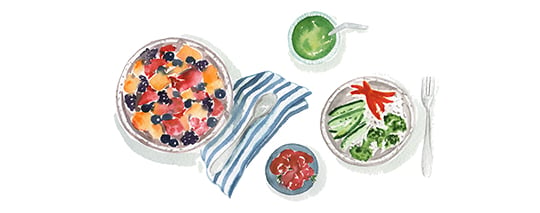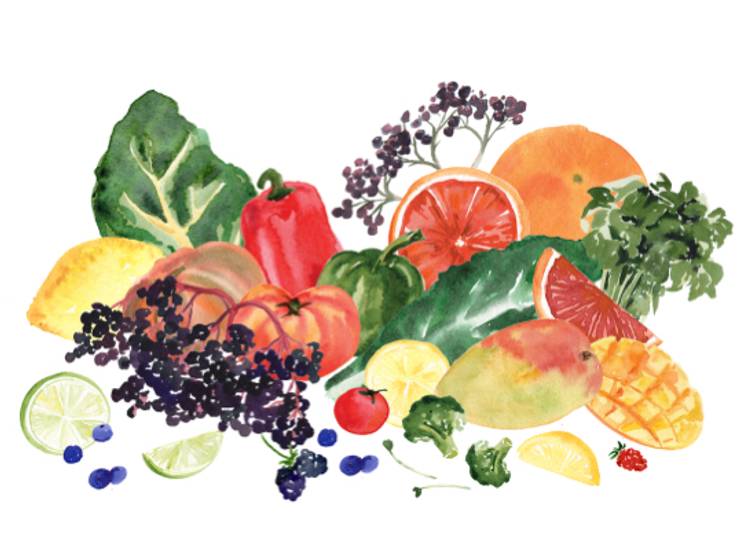Articles
Boosting Immunity: How Your Food Choices Keep You Healthy
You probably know the adage, “An apple a day keeps the doctor away.” Evidence-based research agrees, it’s not a bad strategy. Healthy routines can enhance your immunity, according to the Centers for Disease Control and Prevention (CDC). 1
It’s not necessarily about the apples but eating well by emphasizing plenty of fruits and vegetables, which provide essential nutrients that support peak immune function. 2
A nutritious diet combined with staying hydrated, getting enough sleep, keeping stress at bay and exercising all help the body stay in balance.
When a cold or flu hits, you can easily lose energy dealing with all those aches and pains. But as you reach for quick relief from products that tout, “boosting our immune system,” have you ever wondered, is it a myth or can we really impact our immune function?
To understand it all, you first have to learn a little more about immunity.

Immunity 101
The immune system is made up of different organs, cells and proteins that work together, according to Johns Hopkins Medicine.3
The system contains two main parts: the innate immune system (what you’re born with) and the adaptive immune system (what you develop as you are exposed to microbes).
The innate side is made up of physical barriers that help protect the body such as the skin and the mucous membrane lining the respiratory and gastrointestinal tracts. Whereas, the adaptive (or acquired) system works to make proteins called antibodies that can protect your body from invaders like viruses and bacteria.
As you can imagine, these systems work together 4 and they stay quite busy throughout the year—not just during cold and flu season.
Jenna Macciochi, PhD, has more than twenty years of experience as a scientist, researching the impact of lifestyle on the immune system in health and disease.
“The immune system is a silent wonder,” she writes in her 2020 book Immunity: The Science of Staying Well―The Definitive Guide to Caring for Your Immune System. “While we are very aware of our hearts beating and the breaths we take, we are much less aware of our immune system and the many jobs it performs to keep us well.”
She defines the immune system as “a whole galaxy of cells, known as white blood cells that also includes lymphatic organs and molecules and their collective array of biological functions.”
That means that immunity is unique to each person. That’s why some people never seem to get sick while others may fall ill more easily. The average adult will deal with about two to three colds a year, according to the CDC. 5
Studies suggest that taking vitamin C supplements when an infection is present can help reduce symptoms and help speed recovery, but most people don’t need to continually supplement. 6
That’s where a well-balanced diet full of fruits and vegetables can help.
So many foods are naturally full of vitamin C such as citrus fruits, mangoes, berries, bell peppers, broccoli, leafy greens and tomatoes. You can easily add any of these delicious ingredients to your favorite juice or smoothie.

Along with vitamin C, you can also stock your pantry with elderberry syrup. Elderberries are small purple berries and one of the most effective home remedies for both viral and bacterial infections.
Research has shown that elderberry extract offers a safe and cost-effective treatment for influenza, 7 helping shorten your stay in bed.
It’s easy to make your own. Try this recipe for Elderberry Syrup, which uses honey. A 2012 review found that honey acts as a natural immunity booster. 8
Elderberries have a small amount of natural toxicity and are not recommended to be eaten raw. Don’t add them to your juicer; it’s better to extract their nutrients with heat.

Listen To Your Gut
Many studies have confirmed a close link between the health of our microbiome and our ability to combat viral illness.
The microbiome is the collection of all microbes, such as bacteria, fungi, viruses and their genes, that naturally live on our bodies and inside us, according to the National Institute of Environmental Health Sciences. 9
These microbes are small but they play a huge part in keeping us healthy and protecting us against pathogens. The microbes found in your intestines are referred to as the gut microbiome.
“The health of your microbiome is an incredibly predictive marker for illness,” according to Dr. Robynne Chutkan, a board-certified gastroenterologist serving on the Georgetown University Hospital faculty.
“Up to 80 percent of your immune system is physically located in your gut,” she explained in a 2022 podcast interview. “Gut bacteria guide that immune response, sending signals to the immune cells.”
In Chutkan’s most recent book, The Anti-Viral Gut, she offers advice for optimizing diet, exercise, sleep and time outdoors to boost the body’s natural defenses, explaining how fiber is a main ingredient for creating a healthy microbiome.
One of the best ways to increase fiber in your diet is to eat a minimum of three servings of vegetables and two servings of fruit every day, which meets the five-a-day recommendation from the USDA's Dietary Guidelines for Americans. 10
About one serving is a single piece of fruit or a half-cup of raw fruits or vegetables, or a cup of leafy greens. If you add fruit and veggies to each meal and your snacks, you’ll easily hit that goal.

Focus On Hydration
Water is essential to life. Staying hydrated is one of the best ways to maintain your overall health.
When you feel thirsty, you may already be dehydrated. Long-term dehydration can lead to many issues including headaches, joint pain, a decreased mood, trouble focusing, digestion issues and more. None of these symptoms feel good, and they can even increase your susceptibility to getting sick.
A great way to stay hydrated is to focus on drinking water throughout the day. Many people start their morning with a big glass or two of water to replenish the body after sleeping. After a workout, you also want to be sure to drink plenty of water to help rehydrate your body.
Drinking fresh juice with hydrating fruits and vegetables like cucumber, melon, celery or lettuce can also help. If you struggle to drink water, you can add a splash of lemon, lime or cucumber slices to make it more palatable.
You can aim to drink about half your weight in ounces. If you weigh 150 pounds, you’ll work to drink about 75 ounces of water each day. One way to know if you are on track is to take a peek at your urine color. It should remain a pale-yellow color throughout the day.

Getting Back To Basics
While the immune system might be a complex structure that requires balance and harmony, our lifestyles can easily shift to help maintain that equilibrium.
“Our delicately balanced immunity is easily compromised by our ever-accelerating pace of life, with its relentless stress, pollution, over-consuming and under-moving,” Macciochi writes.
One of the best strategies for maintaining your health is to slow down and find ways to care for yourself. Focus on a diet full of fruits and vegetables, get adequate sleep and work to minimize stress.
“Sleep deprivation and stress overload increase the hormone cortisol, prolonged elevation of which suppresses immune function, writes Kristina Carrillo-Bucaram, also known as “FullyRaw Kristina,” in her blog. 11 “Getting enough sleep also helps your body to rebuild and restore properly. Not getting enough sleep can wear down your immune system and eventually cause adrenal fatigue, which can lead to other health issues.”
Research suggests that your mood and stress can negatively or positively impact your immune system. 12 Listening to music, spending time with friends, getting outside more often and developing a mindfulness practice are all proven ways to help reduce stress.
And finally, when it comes to immunity, don’t forget to keep your hands clean. An easy way to avoid infection is to be sure to wash your hands frequently with warm soapy water.

Our Favorite Produce Available in February
Here’s our guide to some of the best seasonal fruits and vegetables this month. Remember: seasonal foods will vary depending on where you live, soil conditions and weather.
BEST FEBRUARY FRUITS

GRAPEFRUIT
This large winter fruit gets its name from how it grows—on tree branches in grape-like clusters, according to the Library of Congress. This refreshing, juicy citrus fruit is wonderful on its own for breakfast or can be a great addition to a morning juice. It contains many micronutrients including vitamin C, potassium, magnesium and flavonoids. 13 And don’t forget grapefruit (and its juice) can impact the way your medications work, according to the U.S. Food and Drug Administration. 14 You can learn more here.'
• Shopping Tip: Choose smooth, unblemished fruit that feels substantial for its size.
• Varieties: You can find different varieties based on flesh color, such as pink, ruby or white.
• Storage Tip: You can store it on the counter at room temperature for a few days. After that, put the whole fruit in the fridge to keep it fresh on its own, not inside a bag or container.

SWEET ORANGES
Orange juice is synonymous with breakfast throughout North America. It’s not a bad way to start the day, since its sweet, full of fiber and can provide more than 100 percent of your daily vitamin C requirement. 15
• Shopping Tip: Look for firm, bright and smooth oranges without blemishes or noticeable mold that feel heavy.
• Varieties: One of the most common varieties is navel oranges, but you can also find Valencia, Cara cara, blood oranges and more.
• Storage Tip: You can easily store oranges on your countertop or in a fruit bowl for up to a week at room temperature or store them in your fridge for up to two weeks.
BEST FEBRUARY VEGETABLES AND HERBS

GINGER
This spicy addition to any juice comes from a tropical flowering plant that originates in Southeast Asia but is now grown throughout the world. Ginger is part of the Zingiberaceae family, making it a close relative of turmeric. Among its many benefits is gingerol, a natural component of ginger root, that benefits gastrointestinal motility, or the rate at which food exits the stomach and continues along the digestive process, according to Johns Hopkins Medicine. 16
• Shopping Tip: Look for ginger that has thin skin and give it a sniff. It should be aromatic.
• Storage Tip: You can store it on the counter or in a resealable bag in the fridge for about a week or so. You can also store fresh ginger in your freezer and grate it whenever you need it.

MICROGREENS
These flavorful young veggies supply a ton of concentrated nutrients whether you top your salads with them or add them to your juice or smoothie. They are considered adolescent plants—a little older than a sprout and a little younger than a baby green. Microgreens are packed with essential nutrients such as potassium, iron, zinc, magnesium, copper and antioxidants. 17
• Shopping Tip: Usually sold in precut containers or plastic bags, just be sure the microgreens look fresh, bright in color and crisp. You may find more varieties at farmers’ markets than in the grocery store.
• Varieties: Look for all kinds of microgreens including broccoli, cabbage, watercress, radish, arugula, lettuce, chicory, fennel, celery, beet, spinach and more.
• Storage Tip: You can keep microgreens fresh in the fridge for about a week. Don’t store them in a sealed bag, as they will spoil quicker. Use an opened container with a damp paper towel on top.

WATERCRESS
This flavorful aquatic green vegetable is part of the Brassica family, which also includes broccoli, cabbage and kale. One of the most nutrient-dense foods around, cress is full of vitamins and minerals such as calcium, iron, potassium, vitamins A, C and K and more.18 Its delicate, baby leaves are hardy enough to grow all through the winter. It does have a slightly bitter taste, so it might take a few tries to fully adapt to its flavor. Pair it with sweeter produce like pineapple and cucumber in juices as you develop a taste for it.
• Shopping Tip: Watercress is usually sold in bunches, so look for ones that are not wilted or limp. Watch out for a slimy texture on the leaves, which indicates that they are beginning to spoil.
• Storage Tip: You can give cress a quick rinse in water to remove any soil before storage, and then dry the leaves thoroughly to prevent them from getting limp in the refrigerator. Store these greens in the crisper drawer wrapped in a towel to absorb any excess liquid. Or you can also try storing a bunch like fresh herbs with the stems in a jar or glass of water, changing out the water as needed.
COMMUNITY MEMBER SPOTLIGHT

Juicing Tips
from Paige Heirs
1. What are your favorite immune-boosting juice ingredients?
For me, working with ingredients that support the kidneys, gut and lymphatic system (this is where a large part of your immune system lives), are essential in creating an immune- boosting juice. My favorite combination for this is watermelon, pineapple, lemon and ginger. Not only do these ingredients do wonders for the body, they taste great too.
2. What is your favorite juicing tip?
My favorite juicing tip is to juice high-water content fruits. By using ingredients with lots of water, this will produce lots more juice and therefore be cost effective. Examples of fruits that contain over 80 percent water are; melons, oranges, cucumbers and grapes. With the cost of living going up, this tip is essential in making juicing a key part of your life.
Inspiring Nonprofit to Know About
F.A.R.M.S
F.A.R.M.S is a non-profit, committed to assisting farmers and landowners retain land for future use of next generation farmers. Land loss is an epidemic that has plagued Black farmers and landowners. Every month, 30,000 acres of Black landownership is lost primarily due to non-payment of property tax, eminent domain, unprofitable business models, discrimination, generational out-migration and lack of estate planning. F.A.R.M.S. is committed to creating and supporting programs that educate youth about agriculture in innovative ways.
sources:
- https://www.cdc.gov/nccdphp/dnpao/features/enhance-immunity/index.html
- https://pubmed.ncbi.nlm.nih.gov/31426423
- https://www.hopkinsmedicine.org/health/conditions-and-diseases/the-immune-system
- https://www.ncbi.nlm.nih.gov/books/NBK279364
- https://www.cdc.gov/dotw/common-cold/index.html
- https://www.cochrane.org/CD000980/ARI_vitamin-c-for-preventing-and-treating-the-common-cold
- https://pubmed.ncbi.nlm.nih.gov/15080016
- https://www.ncbi.nlm.nih.gov/pmc/articles/PMC3385631
- https://www.niehs.nih.gov/health/topics/science/microbiome/index.cfm
- https://health.gov/our-work/nutrition-physical-activity/dietary-guidelines
- https://www.fullyraw.com/blog/10-simple-ways-to-boost-your-immune-system
- https://link.springer.com/chapter/10.1007/978-3-030-16996-1_6
- https://pubmed.ncbi.nlm.nih.gov/30592894
- https://www.fda.gov/consumers/consumer-updates/grapefruit-juice-and-some-drugs-dont-mix
- https://www.livescience.com/45057-oranges-nutrition-facts.html
- https://www.hopkinsmedicine.org/health/wellness-and-prevention/ginger-benefits
- https://www.sciencedirect.com/science/article/abs/pii/S0889157516300448
- https://fdc.nal.usda.gov/fdc-app.html#/food-details/170068/nutrients
- Choosing a selection results in a full page refresh.
- Press the space key then arrow keys to make a selection.



